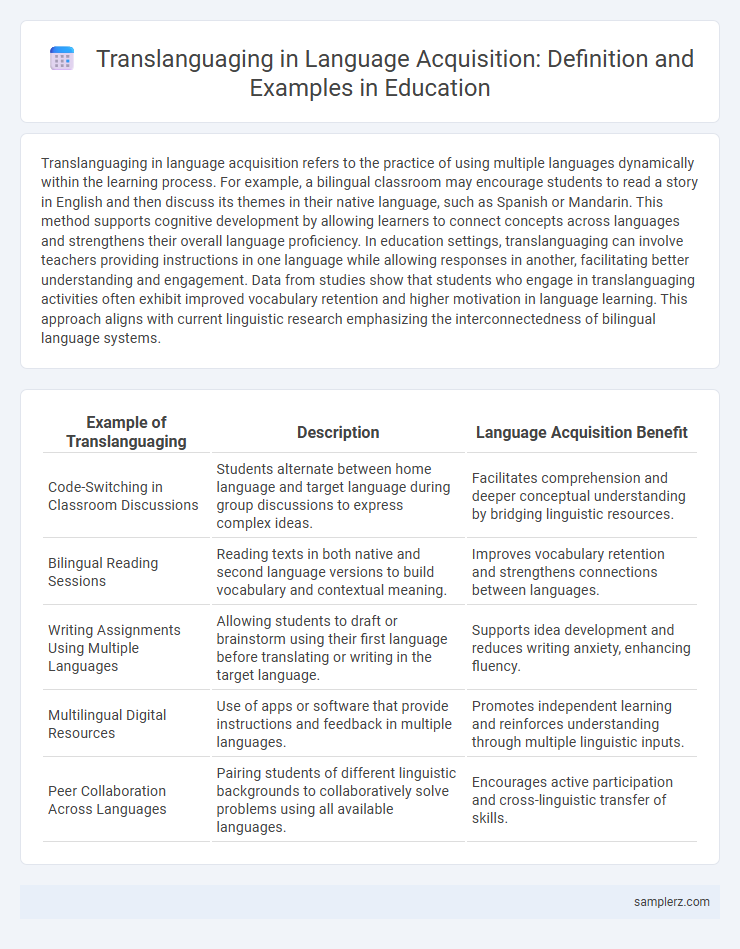Translanguaging in language acquisition refers to the practice of using multiple languages dynamically within the learning process. For example, a bilingual classroom may encourage students to read a story in English and then discuss its themes in their native language, such as Spanish or Mandarin. This method supports cognitive development by allowing learners to connect concepts across languages and strengthens their overall language proficiency. In education settings, translanguaging can involve teachers providing instructions in one language while allowing responses in another, facilitating better understanding and engagement. Data from studies show that students who engage in translanguaging activities often exhibit improved vocabulary retention and higher motivation in language learning. This approach aligns with current linguistic research emphasizing the interconnectedness of bilingual language systems.
Table of Comparison
| Example of Translanguaging | Description | Language Acquisition Benefit |
|---|---|---|
| Code-Switching in Classroom Discussions | Students alternate between home language and target language during group discussions to express complex ideas. | Facilitates comprehension and deeper conceptual understanding by bridging linguistic resources. |
| Bilingual Reading Sessions | Reading texts in both native and second language versions to build vocabulary and contextual meaning. | Improves vocabulary retention and strengthens connections between languages. |
| Writing Assignments Using Multiple Languages | Allowing students to draft or brainstorm using their first language before translating or writing in the target language. | Supports idea development and reduces writing anxiety, enhancing fluency. |
| Multilingual Digital Resources | Use of apps or software that provide instructions and feedback in multiple languages. | Promotes independent learning and reinforces understanding through multiple linguistic inputs. |
| Peer Collaboration Across Languages | Pairing students of different linguistic backgrounds to collaboratively solve problems using all available languages. | Encourages active participation and cross-linguistic transfer of skills. |
Introduction to Translanguaging in Language Acquisition
Translanguaging in language acquisition involves the strategic use of multiple linguistic resources by learners to enhance comprehension and communication. For example, a bilingual student might read a text in English while simultaneously discussing the content in their native language to deepen understanding and reinforce vocabulary retention. This approach supports cognitive flexibility and bridges language gaps, facilitating more effective language development.
Classroom Strategies Incorporating Translanguaging
Classroom strategies incorporating translanguaging in language acquisition involve alternating between students' first and second languages to enhance comprehension and engagement. Techniques such as bilingual dialogue journals, code-switching during instruction, and collaborative group work allow learners to leverage their full linguistic repertoire. These methods support cognitive development, promote deeper understanding, and foster a more inclusive learning environment.
Case Study: Translanguaging in Bilingual Education
The case study on translanguaging in bilingual education highlights how students use both their native language and the target language fluidly to enhance comprehension and communication. This approach allows learners to leverage their entire linguistic repertoire, improving vocabulary acquisition and cognitive flexibility. Research shows that translanguaging supports deeper engagement and academic achievement in diverse classrooms.
Teacher-Student Interaction through Translanguaging
Teacher-student interaction through translanguaging enhances language acquisition by allowing students to use their entire linguistic repertoire for comprehension and expression. For example, a bilingual teacher may alternate between English and Spanish during lessons, enabling students to grasp complex concepts more effectively while building both languages simultaneously. This dynamic approach fosters cognitive flexibility and supports deeper engagement in multilingual classrooms.
Translanguaging in Reading and Writing Activities
Translanguaging in reading and writing activities enables multilingual students to leverage their entire linguistic repertoire, enhancing comprehension and expression. For example, students may read a text in one language while annotating or discussing it in another, promoting deeper understanding and critical thinking. This practice supports cognitive development by allowing learners to fluidly integrate languages, improving literacy skills across their language systems.
Home-School Connection: Family Engagement Using Translanguaging
Translanguaging in language acquisition strengthens home-school connections by encouraging families to use multiple languages during learning activities, fostering deeper engagement. For example, bilingual parents can support vocabulary development by discussing school topics in their native language, enhancing comprehension and cultural identity. This practice leverages students' full linguistic repertoire, promoting academic success and meaningful family involvement.
Digital Tools Supporting Translanguaging Practices
Digital platforms such as Google Translate and multilingual dictionaries facilitate translanguaging by allowing students to switch seamlessly between languages during language acquisition. Language learning apps like Duolingo and Babbel incorporate translanguaging strategies by offering content and feedback in multiple languages, enhancing comprehension and retention. Interactive tools such as Padlet and Flipgrid support collaborative translanguaging practices by enabling learners to express ideas in their preferred languages while engaging with peers in diverse linguistic environments.
Peer Collaboration and Translanguaging Outcomes
Peer collaboration in translanguaging fosters dynamic language acquisition by enabling students to fluidly switch between languages, enhancing comprehension and communication skills. Classroom interactions where learners negotiate meaning through both their first and second languages create deeper cognitive engagement and reinforce bilingual proficiency. Positive translanguaging outcomes include improved vocabulary retention, greater cultural awareness, and increased confidence in using multiple languages effectively in academic contexts.
Challenges and Solutions in Translanguaging Implementation
Translanguaging in language acquisition often faces challenges such as unequal teacher preparedness, limited resources, and resistance to non-standard language use in classrooms. Effective solutions include targeted professional development, creation of multilingual materials, and fostering inclusive attitudes towards linguistic diversity. Implementing supportive policies that recognize translanguaging as a legitimate pedagogical strategy enhances student engagement and language proficiency.
Future Directions for Translanguaging in Language Acquisition
Emerging research emphasizes the integration of translanguaging strategies in digital platforms to enhance multilingual language acquisition, fostering cognitive flexibility and pragmatic competence. Future directions include leveraging artificial intelligence to create adaptive learning environments that dynamically support learners' linguistic resources in real time. Expanding empirical studies on longitudinal impacts of translanguaging will inform pedagogical frameworks that promote equitable and culturally responsive education.

example of translanguaging in language acquisition Infographic
 samplerz.com
samplerz.com